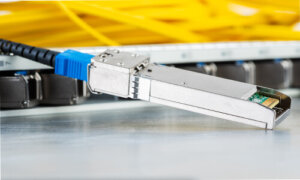As Ethernet speeds, AI, cloud computing, IoT, and virtual data centers advance, data center operators face increasing demands. Despite this, DAC cables retain their market presence, not only within data centers but across various industries, owing to their cost-effectiveness and superior performance for interconnecting data centers. This passage aims to introduce typical DAC cables and their applications in data centers for high-density, high-speed gigabit Ethernet interconnects.
What is DAC Cable?
DAC stands for Direct Attach Cable, also known as direct cable, direct copper cable, or high-speed cable. This type of cable serves as an economical solution for short-distance connections, often replacing optical modules. Each end of the cable features module-like assemblies that connect to fixed ports. Notably, the module head and copper are inseparable in DAC cables. Unlike active optical cables, high-speed cables don’t require expensive optical lasers or electronic components in the connector modules. This leads to cost and power savings for short-distance connections.

What is DAC Breakout Cable?
Breakout cables are occasionally grouped under the category of DAC cables. These breakout DAC cables possess a single connector on one end and multiple connectors (usually 2 or 4) on the other.
To put it simply, it divides a single connector into several connectors. The end with one connector provides a significantly higher speed (e.g., 40G), while the “split” ends operate at a lower speed (10G). This makes the breakout cable valuable for linking ports with different speeds.
In certain situations, the breakout DAC functions as an adapter, enhancing lower-speed ports to higher-speed ones and boosting the density of faceplate ports.
DAC Cables Types
Based on the availability of signal conditioning functions, we can divide them into passive and active DAC.

Passive DAC Cable
Passive DAC cables lack electronics for signal conditioning and amplification. Consequently, they are more affordable but have limited reach (typically up to 7m for 10G). Over longer distances, passive cables can result in a higher number of bit errors.
Active DAC Cable
Active DAC cables incorporate microprocessors and other electronics for signal conditioning and amplification, delivering enhanced performance for longer transmissions. Active cables come at a higher cost than passive ones and are pricier than AOC cables. Before opting for an active cable, it’s advisable to compare total costs with AOC or fiber transceivers, potentially uncovering a more cost-effective solution.
Based on Data Rate and Form Factor, it can be divided into the followings:
10GbE/ 40GbE Generation
- 10GbE to 10GbE: SFP+ to SFP+
- 40GbE to 40GbE: QSFP+ to QSFP+
- 40GbE to 4x 10GbE: QSFP+ to 4x SFP+
- 40GbE to 1x 10GbE: QSFP+ to SFP+
25GbE/ 50GbE/ 100GbE Generation
- 25GbE to 25GbE: SFP28 to SFP28
- 50GbE to 50GbE: QSFP28 to QSFP28
- 100GbE to 100GbE: QSFP28 to QSFP28
- 100GbE to 4x 25GbE: QSFP28 to 4x SFP28
- 100GbE to 2x 50GbE: QSFP28 to 2x QSFP28
- 100GbE to 1x 25GbE: QSFP28 to 1x SFP28
- 100GbE to 1x 50GbE: QSFP28 to 2x QSFP28
How Far Do DACs Reach?
DACs (Direct Attach Cables) have varying reach capabilities depending on the type and vendor. As we move beyond 100GbE speeds, DACs typically have limited reach, often around 5 meters or shorter.
As DACs transition to higher speeds, they require increased shielding, resulting in thicker and less flexible cables. For instance, a QSFP28 100GbE DAC is bulkier and stiffer than a QSFP+ 40GbE DAC, making cable routing more challenging.
Passive DACs consume less power, while active DACs use more power and offer slightly greater reach. However, even active DACs cannot match the reach of optical connections.
It’s important to note that there are also Active Optical Cables (AOCs) that resemble DACs in pre-assembled fixed-length solutions. AOCs utilize optical communication, enabling them to reach longer distances compared to DACs.
Why Choose DAC Cables Over Optical Transceivers?
- High Performance: DAC cables are ideal for short-distance connections within data centers due to their seamless integration and strong interchangeability.
- Energy Efficiency and Environmentally Friendly: DAC cables are made of copper, which naturally dissipates heat well. This contributes to energy efficiency and aligns with environmental protection goals.
- Low Power Consumption: Passive DAC cables require no additional power supply, resulting in minimal power consumption, practically approaching zero.
- Cost-Effective: Copper cables used in DACs are significantly more affordable than fiber cables. This cost difference translates to substantial savings in overall data center wiring expenses.
Final Words
In the fast-evolving landscape of data centers and connectivity, DAC cables have experienced significant market growth, capturing a substantial portion of the IDC market. With data speeds approaching 400G within data centers, DAC high-speed cable solutions are increasingly adopted by clients due to their cost-effectiveness, high transmission rates, and minimal signal loss. Many high-speed data centers now favor DAC products as their preferred communication solution.




